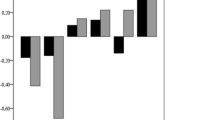Abstract
“Unity” and “diversity” are best reconciled by Darwin's Theory of Evolution. Two major dilemmas related to the study of Evolution are described. The first, concerning pedagogy, can be solved by teaching the topic at an elementary level in the middle school so that the Theory may serve as an “advanced oragnizer” and returning with in-depth study in the last two years of high school. The second, concerning Faith, is a sensitive issue. Some successful approaches are discussed. The place of Darwin's Theory in the all-elective high school biology curriculum is described as well. The role of the Theory regarding explanations is especially highlighted.
Similar content being viewed by others
References
Agressing, J.P.A. (1978). Problem solving exercises and evolution teaching.Journal of Biological Education,12, 16–20.
Ausubel, D. P. (1968).Educational psychology: A cognitive view. New York: Holt, Reinhart & Winston.
Bartov, H. (1978). Can students be taught to distinguish between teleological and causal explanations?Journal of Research in Science Teaching,15, 567–572.
Biological science: The web of life. (1975). Melbourne: The Australian Academy of Science.
Brumby, M. (1979). Problems in learning the concept of natural selection.Journal of Biological Education,13, 119–122.
Committee on High School Biology Education. (1990).Fulfilling the promise: Biology education in the nation's schools. Washington, DC: National Academy Press.
Deadman, J. A., & Kelly, P. J. (1978). What do secondary school boys understand about evolution and heredity before they are taught the topics?Journal of Biological Education,12, 7–15.
Government of Israel. Ministry of Education and Culture. (1990).Highschool biology syllabus. Jerusalem: author (in Hebrew).
Jungwirth, E. (1975). Preconceived adaptation and inverted evolution: A case of distorted concept formation in highschool biology.Australian Science Teacher Journal,21, 95–100.
Jungwirth, E. (1985). A multi-contextual approach to the teaching of the “Idea of evolution.” In A. M. Mayer & P. Tamir (Eds.),Science teaching in Israel: Origins, development and achievements (pp. 155–159). Jerusalem: Israel Science Teaching Cenre.
Kahle, J. B. (1990). Real students take chemistry and physics: Gender issues. In K. Tobin, J. B. Kahle, & B. J. Fraser (Eds.),Windows into science classrooms: Problems associated with higher level cognitive learning (pp. 92–134). London: Falmer Press.
Keeton, W. T. (1967).Biological science. New York: Norton.
Lucas, A. M. (1971). The teaching of adaptation.Journal of Biological Education,5, 86–90.
Novak, J. D. (1977).A theory of education. Ithaca: Cornell University Press.
Schwab, J. J. (1963).Biology teacher's handbook. New York: Wiley.
Toulmin, S. (1972).Human understanding, Vol. 1: The collective use and evolution of concepts. Princeton: Princeton University Press.
Yacobson, Y. (1984). The educational contribution of teaching evolution by a historical philosophical approach. Unpublished doctoral dissertation, Jerusalem, Hebrew University (in Hebrew).
Author information
Authors and Affiliations
Rights and permissions
About this article
Cite this article
Tamir, P. The curriculum potential of Darwin's Theory of Evolution. Interchange 24, 73–86 (1993). https://doi.org/10.1007/BF01447341
Issue Date:
DOI: https://doi.org/10.1007/BF01447341




